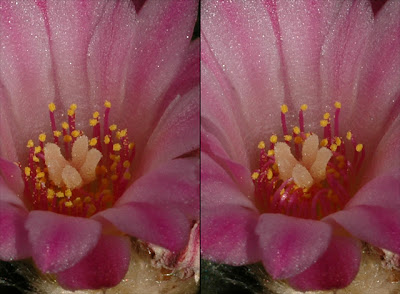One of my Lophophora williamsii v. jourdaniana plants is flowering again – this time with the full cooperation of the sun, resulting in a much more well-developed flower compared to the previous one.
Flowering Lophophora jourdaniana
My two Lophophora williamsii v. jourdaniana plants are almost in full compliance with Habermann’s description (rose-violet perianth, pistil, and filaments; persistent spines on young areoles) but the open flower clearly contradicts Habermann’s claim of cleistogamic flowers (i.e. flowers that do not open and are self pollinated). Apparently Habermann misunderstood or used this term incorrectly as the photo accompanying the type description also shows a plant with an open flower ;-)
Lophophora jourdaniana – thigmotropic stamens
Like many other species of cacti (including the other Lophophora species/varieties) L. jourdaniana has thigmotropic stamens, i.e. stamens that when touched fold in around the style (as is evident for the front stamens in the rightmost picture).
The following stop motion video provides a better illustration of the thigmotropic mechanism - I'll try to make a higher quality movie the next time the plant flowers.
References
Vlastimil Habermann (1975), “Lophophora jourdaniana Habermann species nova”, Kaktusy 11 (1), 3
Malpighia 1927 v.30 (added: 11/24/2025)
-
*By:*
Borzi, Antonino,1852-1921.
Penzig, O.1856-1929.
Pirotta, Romualdo,1853-1936.
*Publication Info:*
Messina : g. Capra & co., 1887-89 ; Genova : Tip. di A...
1 month ago



















Great information and video. picture,1000 words; video, the whole story!
ReplyDeleteThis is a really amazing site! I really need some help please, i have two peyote that I'm scared are dying. I don't know what is wrong. Is someone willing to help me? I can send photo's?
ReplyDeleteCraig if you are willing to share the photos you could join http://groups.google.com/group/lophophora - once you are a member just drop a mail to “lophophora [at] googlegroups [dot] com” with the photos attached.
ReplyDeleteOtherwise you can reach me directly at “lophophora [dot] blog [at] gmail [dot] com” (I'm travelling at the moment and might be a bit slow replying, so the google group would be the best option).
I have seen the same thing in the naturel habatat with other lopho, species as well as other cacti species,I do not feal that is a contrubuting factor(sorry my spelling sucks)in species ID
ReplyDeleteDanny you're right - the wording was misleading on this; I've tightened it to make it clear that thigmotropic stamens are a common trait.
ReplyDelete